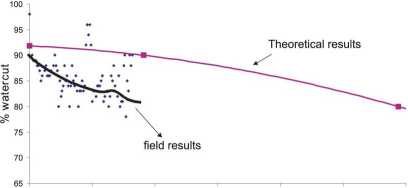5441337316
ability of the sand is approximately 1-3 Darcy and porosity is 31%. The reservoir pressure of 1750 psia is maintained by an active aąuifer.
A numerical simulation model including actual reservoir data was used to design the DWS installation. After history matching the model was used to evaluate different DWS scenarios. The well was converted to DWS with a 10-ft long top completion located at the top of the oil zonę (4731 -ft to 4741-ft). Bottom completion was 5-ft long and located 5-ft below what was believed to be the current oil-water contact. Water was drained using a rod-pumping unit at ratę of 900 BWPD, and the top perforated interwal was produced at 25 BOPD with a WC of 58%. Production data indicates that the total WC for the well was 97.4%, which is close to the WC the well had before the re-completion.
Two DWS installations were placed in two wells in Venezuela in 2001 and 2002. The first installation was madę by re-completing an old well located in La Victoria field. The reservoir contains undersaturated crude oil with Iow bubble-point pressure and Iow solution GOR. The major recovery mechanism is strong water drive from an immense Artesian aąuifer supplied from the Andes. The rock is poorly Consolidated shaly sand with high porosity (25-30%) and permeability (1000-3000 mD). The well was severely water out and DWS installation was used to reduce water cut at the top completion. Figurę 4 shows the water cut results over the for the three-month long water drainage in their well. Notę that the actual water-cut reduction was significantly higher than the one predicted theoretically. After three month of operation the well encounter mechanical problems (not related to DWS) and the test was terminated.

0 50 100 150 200 250 300
time, days
Fig. 4. DWS application for a well in La Yictoria field, Yenezuela
In 2002, another DWS installation was madę in Venezuela in an oil well located in San Silvestre Field [10]. The well was initially a conventional producer with a single completion. However, in 2001, as the initial well production showed very high 96% water cut the well was soon shut-in while producing 100 BOPD. In January 2002 the well was re-completed and converted to DWS. Both completions were eąuipped with electric sub-mersible pumps (ESP). Oil ratę increased from 100 to 295 BOPD (175 BOPD from the top
580
Wyszukiwarka
Podobne podstrony:
41302 mc02 Which Are the Muscles of Posturę (Erection)? Our cquilibrium is maintaiued by thc opposmg
52 2.3 Introduction Phenotypic flexibility is the ability of a fully-developed organism to rapidly a
KI: possesses the ability of the analytical thinking, works with big amount of data, is able to make
skanowanie0014 (47) • The communicative teaching is marked by an atmosphere of using and working wit
UHAM062 THE CAUSES OF HEADACHE AND MIGRAINE ^ 45 genuinely intense, or if it is accompanied by other
sulf of sulfate that is activated by the formation of adenosine phosphosulfate (APS) and its subsequ
Polishchuk T., Mosakowska M.: The Balance and Jumping Ability of Artistic Gymnastics Competitors of
The Natural Ąpproach The natural approacli is a metliod of second language teaching proposed by S. K
6. The reproductive ability of enterprises is falling. The share of economie
CSG210 Nouns and Articles 199Plural of Nouns The plural of nouns in Spanish is formed by adding the
Bułgaria 22 shaft is seoared by means of a doobie Gardan joint and a Steel bar with alte-rating leng
więcej podobnych podstron